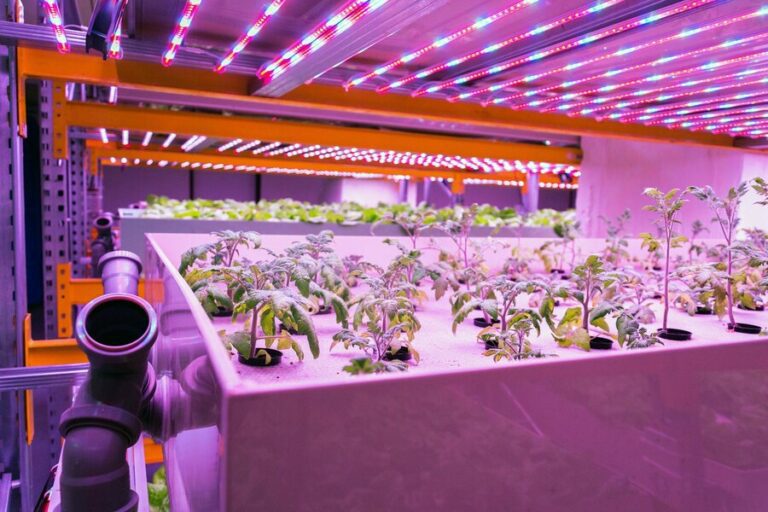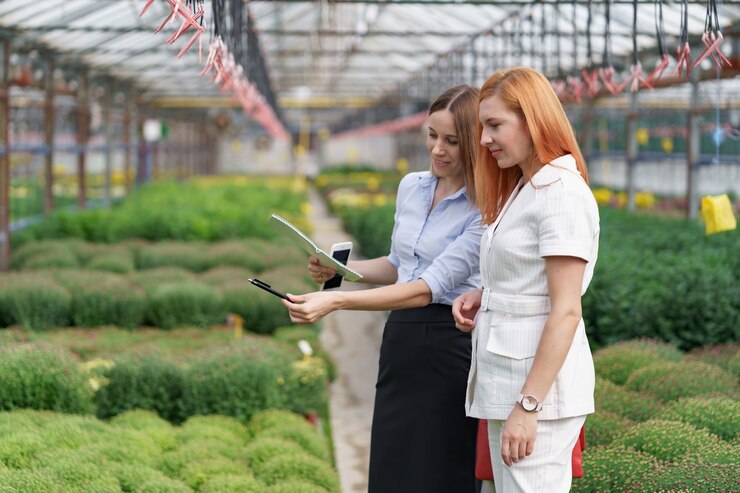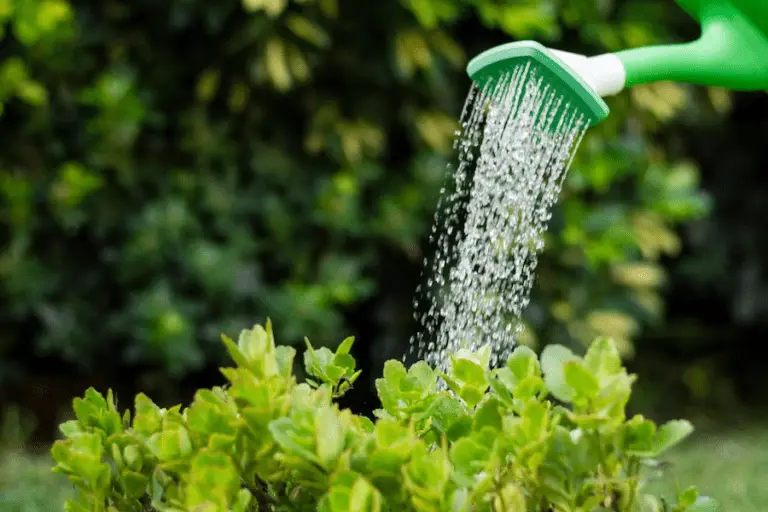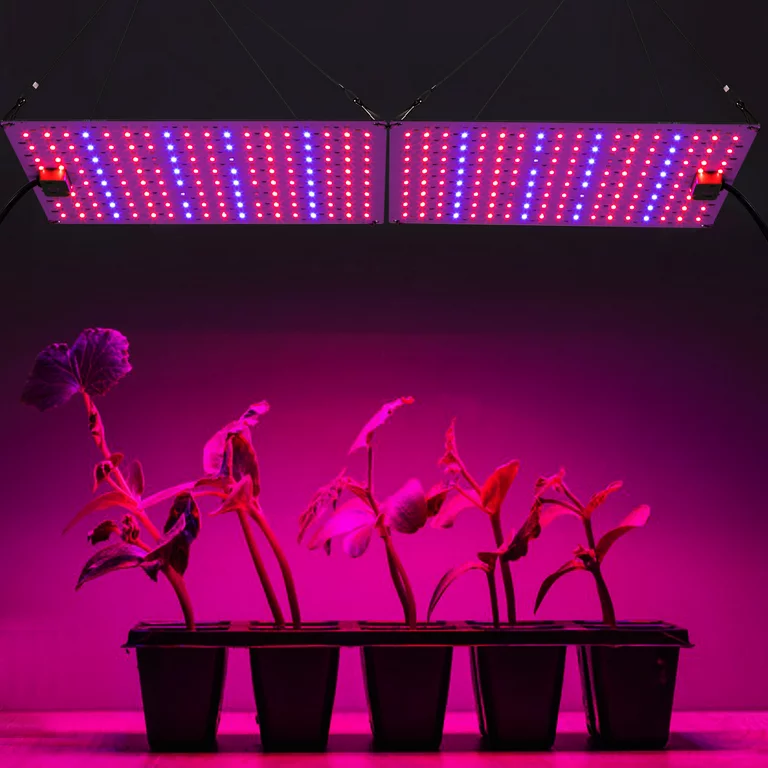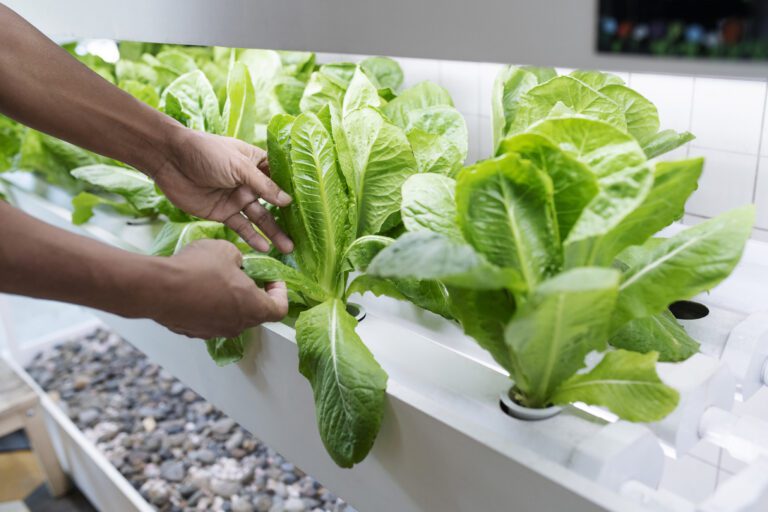Navigating Your Choices: Finding the Right Hydroponic System
Table of Contents
Benefits of Hydroponic Systems for Indoor Gardening
Hydroponic systems offer numerous benefits for indoor gardening, making them an increasingly popular choice for gardening enthusiasts. One major advantage is that these systems allow plants to grow in a soilless environment, which eliminates the risk of soil-borne diseases and pests. This not only ensures healthier plants but also reduces the need for harmful chemical pesticides and herbicides.
Another benefit of hydroponic systems is their ability to optimize the use of water and nutrients. Unlike traditional soil-based gardening, where water and nutrients can be wasted or unevenly distributed, hydroponic systems provide precise control over the delivery of these essential elements. This not only leads to more efficient water usage, but it also allows plants to receive a perfectly balanced supply of nutrients, resulting in faster growth, higher yields, and superior quality produce.
In addition, hydroponic systems offer the advantage of year-round gardening. By creating a controlled environment indoors, gardeners can overcome the limitations imposed by seasonal changes and external factors such as weather conditions. This means that regardless of the time of year, plants can be grown consistently and harvested at any time, providing a continuous supply of fresh produce. Furthermore, the ability to grow plants indoors allows for greater flexibility in terms of available space, making hydroponics an ideal choice for urban dwellers or those with limited outdoor areas.
When it comes to indoor gardening, hydroponic systems present an array of benefits that can greatly enhance your gardening experience. From disease-free plants and efficient resource utilization to year-round availability and greater flexibility in space management, these systems offer an innovative and sustainable solution for growing plants indoors. By embracing hydroponics, gardening enthusiasts can unlock the full potential of their indoor spaces and enjoy a fruitful and fulfilling gardening journey.
• Hydroponic systems eliminate the risk of soil-borne diseases and pests, ensuring healthier plants.
• These systems reduce the need for harmful chemical pesticides and herbicides.
• Hydroponic systems optimize water usage and provide precise control over nutrient delivery.
• Plants receive a perfectly balanced supply of nutrients, resulting in faster growth, higher yields, and superior quality produce.
• Year-round gardening is possible with hydroponic systems by creating a controlled indoor environment.
• Seasonal changes and external factors such as weather conditions do not limit plant growth.
• Plants can be grown consistently and harvested at any time, providing a continuous supply of fresh produce.
• Hydroponics allows for greater flexibility in terms of available space, making it ideal for urban dwellers or those with limited outdoor areas.
Different Types of Hydroponic Systems
Hydroponic systems offer gardeners an efficient and controlled method of cultivating plants indoors, free from the limitations of traditional soil-based gardening. There are several different types of hydroponic systems available, each with its own unique advantages and considerations.
One popular type is the nutrient film technique (NFT) system. In an NFT system, a thin film of nutrient-rich water is continuously circulated over the roots of the plants. This allows for maximum water and nutrient absorption, while also providing ample oxygen to the roots. NFT systems are ideal for smaller plants with shallow root systems, such as lettuce or herbs.
Another commonly used system is the ebb and flow, or flood and drain, system. In this setup, the plants are periodically flooded with nutrient solution, which is then drained away. This cycle of flooding and draining ensures that the plants receive enough water and nutrients without becoming waterlogged. Ebb and flow systems are versatile and can accommodate a wide range of plant sizes, making them suitable for a variety of crops.
Drip systems, on the other hand, deliver nutrient solution directly to the roots of the plants through a network of tubes and emitters. This method provides precise control over the amount of water and nutrients each plant receives, making it an excellent choice for larger, more demanding plants. Drip systems can also be automated, reducing the need for constant monitoring and manual adjustments.
As with any gardening technique, it’s essential to consider the specific needs of your plants and your desired level of involvement before choosing a hydroponic system. Evaluating factors such as space, budget, and your own expertise will help you select the system that best suits your needs and ensures successful indoor gardening. So, let’s explore these factors further to help you make an informed decision.
• Nutrient film technique (NFT) system:
– Thin film of nutrient-rich water continuously circulates over roots
– Maximum water and nutrient absorption
– Ideal for small plants with shallow root systems
• Ebb and flow (flood and drain) system:
– Periodically floods plants with nutrient solution, then drains away
– Ensures adequate water and nutrients without waterlogging
– Versatile and suitable for a variety of plant sizes
• Drip systems:
– Delivers nutrient solution directly to plant roots through tubes and emitters
– Provides precise control over water and nutrient amounts
– Excellent choice for larger, demanding plants
Factors to consider when choosing a hydroponic system:
– Space availability: Different systems require varying amounts of space.
– Budget: Some systems may be more costly to set up than others.
– Expertise level: Consider your experience with hydroponics before selecting a system.
– Plant needs: Assess the specific requirements of your desired crops.
– Level of involvement: Determine how much time you can dedicate to monitoring and adjusting the system.
By considering these factors, you can make an informed decision that will result in successful indoor gardening using hydroponic systems.
Factors to Consider Before Choosing a Hydroponic System
When considering the selection of a hydroponic system for your indoor gardening needs, there are several factors that must be taken into account. One crucial factor is the size of your space. Determine how much room you have available and whether you want a system that can be easily expanded in the future. It’s also important to assess your budget and the costs associated with different types of hydroponic setups. Factors such as the initial investment, ongoing maintenance, and energy consumption should all be considered.
Another factor to consider is the level of expertise you have in hydroponics. Are you a beginner just starting out, or do you have experience in this field? Some systems require more knowledge and skill to operate effectively, while others are designed for beginners with simplified setups. Assessing your level of expertise will help you choose a system that aligns with your capabilities and ensures a successful gardening experience.
Additionally, consider the specific goals you have for your hydroponic garden. Are you looking to grow a variety of plants or focus on specific crops? Different hydroponic systems may be more suitable for specific plants or growing conditions. Understanding your goals will enable you to choose a system that can meet your desired outcomes.
In conclusion, when choosing a hydroponic system, it is essential to consider factors such as space availability, budget, your level of expertise, and your gardening goals. By carefully evaluating these factors, you can select the most suitable hydroponic system that will help you achieve success in your indoor gardening endeavors.
• Size of your space: Determine the available room and consider if you want expandability in the future.
• Budget considerations: Assess the costs associated with different hydroponic setups, including initial investment, maintenance, and energy consumption.
• Level of expertise: Evaluate your knowledge and skill level in hydroponics to choose a system that aligns with your capabilities.
• Specific goals: Consider whether you want to grow a variety of plants or focus on specific crops, as different systems may be more suitable for certain plants or growing conditions.
Evaluating Your Space and Budget for a Hydroponic System
When considering the space and budget for a hydroponic system, it is essential to evaluate your available area and financial resources. One of the major advantages of hydroponics is that it can be set up in a variety of spaces, from small indoor areas to larger commercial setups. Assess the available space you have, whether it’s a spare room, a basement, or even a balcony, and determine how much of that can be allocated to your hydroponic system. Consider factors such as the size and height of your plants, as well as any additional equipment that may be required, such as lighting and ventilation systems.

Budget is another crucial consideration when planning your hydroponic system. While it is possible to start small and gradually expand, it’s important to factor in the costs of equipment, supplies, and ongoing maintenance. Research and compare the prices of hydroponic systems, nutrient solutions, grow lights, and other necessary components to get a sense of the investment required. Additionally, take into account potential expenses such as electricity costs and replacement parts. By carefully evaluating your space and budget, you can make informed decisions and ensure that your hydroponic system meets your needs while staying within your financial capabilities.
• Assess the available space you have, whether it’s a spare room, a basement, or even a balcony
• Consider factors such as the size and height of your plants
• Determine how much of the available space can be allocated to your hydroponic system
• Take into account any additional equipment that may be required, such as lighting and ventilation systems
• Research and compare the prices of hydroponic systems, nutrient solutions, grow lights, and other necessary components
• Factor in ongoing maintenance costs for your hydroponic system
• Consider potential expenses such as electricity costs and replacement parts
• Start small if necessary and gradually expand based on your budget capabilities
By carefully evaluating your space and budget:
– You can make informed decisions about the size and setup of your hydroponic system.
– You can ensure that you allocate enough resources for proper plant growth.
– You can avoid overspending by comparing prices before making purchases.
– You can plan for ongoing maintenance costs to keep your system running smoothly.
Assessing Your Goals and Level of Expertise in Hydroponics
Assessing your goals and level of expertise is an essential step before embarking on a hydroponic gardening journey. As with any endeavor, it’s crucial to have a clear understanding of why you want to engage in hydroponics and what you hope to achieve. Are you looking to grow fresh vegetables year-round for personal consumption? Are you aiming to turn hydroponics into a profitable business venture? Defining your goals will help guide your decision-making process and determine the scale and complexity of your hydroponic system.
Additionally, assessing your level of expertise is equally important. Hydroponics can be a complex and intricate method of gardening that requires attention to detail and a certain level of horticultural knowledge. If you’re a beginner, it may be wise to start with a more straightforward and user-friendly hydroponic system, such as a nutrient film technique (NFT) or deep water culture (DWC) setup. These systems are relatively easier to manage and can be a great way to familiarize yourself with the basics of hydroponic gardening. On the other hand, if you’re an experienced gardener with a strong understanding of plant biology and nutrient management, you may opt for more advanced systems like aeroponics or ebb and flow. Considering your expertise level will ensure that you select a hydroponic system that aligns with your skills and knowledge, setting you up for success in your indoor gardening endeavors.
• Assess your goals and determine why you want to engage in hydroponics
• Define what you hope to achieve through hydroponic gardening
• Consider if you want to grow fresh vegetables for personal consumption or turn it into a profitable business venture
• Use your goals as a guide for decision-making and determining the scale and complexity of your hydroponic system
• Evaluate your level of expertise in horticulture and hydroponics
• Recognize that hydroponics can be complex and require attention to detail
• If you’re a beginner, start with a simpler system like NFT or DWC
• These systems are easier to manage and help familiarize yourself with the basics of hydroponic gardening
• If you’re experienced, consider more advanced systems like aeroponics or ebb and flow
• Choose a system that aligns with your skills and knowledge
Exploring Nutrient Delivery Methods in Hydroponic Systems
Hydroponic systems offer a wide range of nutrient delivery methods that ensure plants receive the necessary elements for growth and development. One common method is the use of a nutrient solution that is dissolved in water. This solution is carefully formulated to provide a balanced mix of essential nutrients, including nitrogen, phosphorus, potassium, and micronutrients. The solution is then delivered directly to the plant roots, either through a continuous flow system or a drip irrigation system.
Another popular nutrient delivery method is through the use of nutrient film technique (NFT) systems. In this method, a thin film of nutrient solution is circulated over the plant roots, allowing them to absorb the necessary nutrients. This method is highly effective in providing plants with the nutrients they need while minimizing water and nutrient wastage. NFT systems are commonly used for growing leafy greens and herbs, and they can be easily scaled up or down depending on the size of your indoor garden.
Choosing the right nutrient delivery method for your hydroponic system is crucial in ensuring optimal plant growth and health. Factors such as the type of plants you want to grow, your available space, and your budget should all be considered. Additionally, it is important to regularly monitor and adjust the nutrient solution to maintain the proper pH and EC levels for your plants. By understanding the different nutrient delivery methods available and selecting the most suitable one for your specific needs, you can create an efficient and productive indoor garden.
• Nutrient solution dissolved in water is a common method for delivering nutrients in hydroponic systems
• The solution provides a balanced mix of essential nutrients, including nitrogen, phosphorus, potassium, and micronutrients
• Delivery can be done through continuous flow or drip irrigation systems
• Nutrient film technique (NFT) systems circulate a thin film of nutrient solution over plant roots for absorption
• NFT systems are effective in providing necessary nutrients while minimizing wastage of water and nutrients
• NFT systems are commonly used for growing leafy greens and herbs and can be easily scaled up or down based on garden size
• Factors such as plant type, available space, and budget should be considered when choosing a nutrient delivery method
• Regular monitoring and adjustment of the nutrient solution’s pH and EC levels is important for optimal plant growth
By understanding the different nutrient delivery methods available and selecting the most suitable one for your specific needs, you can create an efficient and productive indoor garden.
Analyzing Lighting Options for Hydroponic Setups
When it comes to hydroponic setups, choosing the right lighting is crucial for the success of your indoor garden. Different types of lighting options are available, each with its own set of advantages and considerations.
One popular choice for hydroponic lighting is LED (light-emitting diode) lights. LED lights are energy-efficient and have a long lifespan, making them a cost-effective option in the long run. They also provide a full spectrum of light that can be tailored to meet the specific needs of different plant varieties. Additionally, LED lights produce very little heat, reducing the risk of burning your plants. However, LED lights can be more expensive upfront compared to other lighting options.
• LED lights are energy-efficient and have a long lifespan
• They provide a full spectrum of light that can be tailored to plant needs
• LED lights produce very little heat, reducing the risk of burning plants
• However, LED lights can be more expensive upfront compared to other options
Another popular lighting option for hydroponic setups is fluorescent lights. Fluorescent lights are relatively affordable and widely available. They emit a cool spectrum of light that is suitable for most plant varieties. Additionally, fluorescent lights do not produce as much heat as some other options, making them safer for indoor gardening. However, they may not provide the same intensity or coverage as other types of lighting.
• Fluorescent lights are affordable and widely available
• They emit a cool spectrum of light suitable for most plants
• Fluorescent lights do not produce excessive heat like some alternatives
• May not provide the same intensity or coverage as other lighting options
High-intensity discharge (HID) lamps are another option worth considering for hydroponic setups. These lamps include metal halide (MH) and high-pressure sodium (HPS) bulbs. HID lamps offer high levels of brightness and intensity, which can promote rapid growth in plants. However, they also generate significant amounts of heat and require proper ventilation to prevent overheating issues. Additionally, HID lamps tend to consume more electricity than LED or fluorescent options.
• HID lamps offer high levels of brightness and intensity
• Can promote rapid growth in plants
• Generate significant amounts of heat requiring proper ventilation
• Consumes more electricity compared to LEDs or fluorescents
In conclusion, choosing the right lighting option for your hydroponic setup requires careful consideration based on factors such as cost-effectiveness, energy efficiency, plant requirements, and potential heating issues. While LED lights may be more expensive upfront compared to alternatives like fluorescent or HID lamps; their energy efficiency,
longevity,
and ability to provide a tailored spectrum of light make them an attractive option for many indoor gardeners. Ultimately, the choice of lighting will depend on your specific needs and budget.
Let’s delve into the analysis of lighting options for hydroponic setups. Proper lighting is crucial for successful plant growth in soilless systems. Below, I’ve created a table comparing different types of hydroponic grow lights:
| Light Type | Description | Suitable Growth Stage |
|---|---|---|
| LEDs (Light-Emitting Diodes) | Energy-efficient and cost-effective. Provide a mix of wavelengths for overall plant health. | All growth stages (vegetative, flowering, and fruiting). |
| Fluorescent Bulbs | Ideal for seed starting and early seedling growth. Affordable but less intense than other options. | Seedlings and young plants. |
| Metal Halide (MH) Bulbs | Emit strong, balanced light. Good for vegetative growth. | Vegetative stage. |
| High-Pressure Sodium (HPS) Bulbs | Excellent for flowering and fruiting. High-intensity light. | Flowering and fruiting stages. |
Remember that the choice of lighting depends on factors like plant type, growth stage, and budget. Each type has its advantages, so consider your specific needs when selecting the right lighting for your hydroponic garden!
Understanding the Importance of pH and EC Levels in Hydroponics
Maintaining the proper pH and electrical conductivity (EC) levels in a hydroponic system is crucial for the success of your indoor garden. pH refers to the acidity or alkalinity of the nutrient solution, while EC measures the level of dissolved salts in the solution. These two factors play a key role in nutrient uptake and overall plant health.
Proper pH levels ensure that nutrients are available in their optimal form for plant absorption. Most hydroponic plants thrive in a slightly acidic pH range of 5.5 to 6.5. If the pH deviates too far from this range, nutrient deficiencies or toxicities may occur, hindering plant growth. Regularly testing and adjusting the pH of your nutrient solution is essential to maintain a healthy and productive hydroponic system.
Similarly, EC levels must also be carefully monitored and adjusted. EC indicates the strength of the nutrient solution and its ability to conduct an electrical current. By measuring EC, you can determine the concentration of salts in the solution. It is important to find the right balance – a high EC may lead to nutrient imbalances and salt buildup, while a low EC may indicate insufficient nutrient levels for plant growth. Balancing the EC ensures that plants receive the appropriate amount of nutrients to thrive without experiencing nutrient burn or deficiencies.
In the next section, we will explore the different methods of adjusting pH and EC levels in a hydroponic system, as well as the tools and equipment needed for accurate measurement and monitoring. Understanding and managing these factors will help you create an optimal growing environment for your hydroponic plants.
• Maintaining proper pH and EC levels is crucial for the success of a hydroponic system.
• pH refers to the acidity or alkalinity of the nutrient solution, while EC measures the level of dissolved salts.
• Proper pH levels ensure optimal nutrient absorption by plants.
• Most hydroponic plants thrive in a slightly acidic pH range of 5.5 to 6.5.
• Deviations from this range can lead to nutrient deficiencies or toxicities that hinder plant growth.
• Regularly testing and adjusting the pH is essential for a healthy and productive hydroponic system.
• EC levels indicate the strength of the nutrient solution and its ability to conduct an electrical current.
• Measuring EC helps determine salt concentration in the solution.
• Balancing EC ensures appropriate nutrient levels for plant growth without experiencing imbalances or deficiencies.
In conclusion, understanding and managing pH and EC levels are vital aspects of successful hydroponics gardening. By maintaining proper balance, you can optimize nutrient uptake, prevent deficiencies or toxicities, and create an ideal growing environment for your plants. In our next section, we will delve into different methods of adjusting these levels as well as explore tools and equipment necessary for accurate measurement and monitoring in your hydroponic system.
Choosing the Right Growing Medium for Your Hydroponic System
Choosing the right growing medium for your hydroponic system is crucial for the overall success of your indoor gardening venture. The growing medium serves as a substitute for traditional soil, providing support, anchorage and a base for nutrient absorption. While there are various options available, it is important to consider the specific needs of your plants and the requirements of your hydroponic system.
One popular choice for a growing medium in hydroponics is coconut coir. This fibrous material, derived from coconut husks, is highly absorbent and provides excellent water retention. It promotes good aeration, allowing the roots to breathe and preventing waterlogging. Coconut coir is also renewable and sustainable, making it an environmentally friendly option for hydroponic growers. Another option to consider is perlite, a lightweight volcanic rock that offers exceptional drainage and aeration. It helps to prevent the roots from becoming saturated and provides stability for the plants. Perlite is also resistant to decomposition, ensuring long-lasting performance in your hydroponic system.
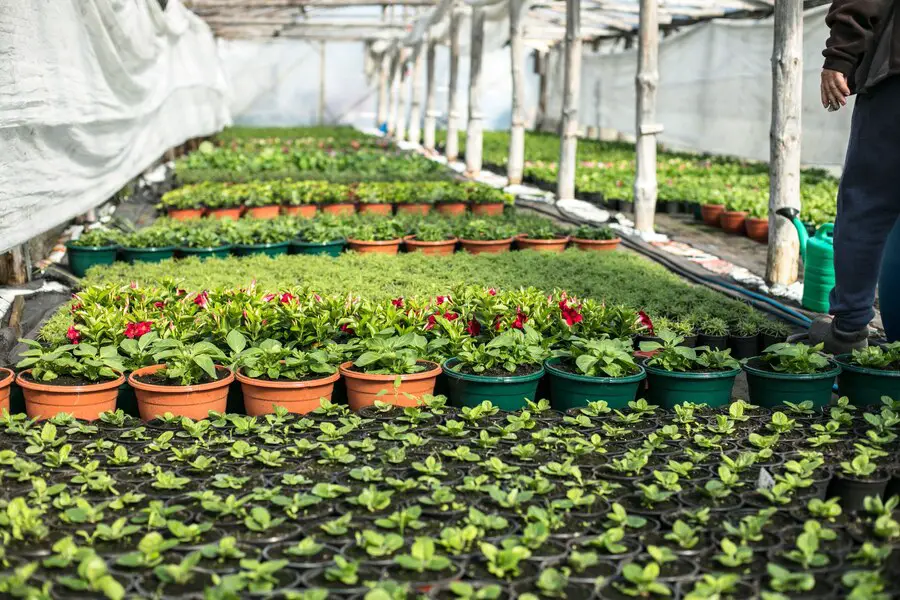
When selecting a growing medium for your hydroponic system, it is important to weigh the advantages and disadvantages of each option to find the most suitable one for your specific needs. Consider factors such as water retention, aeration, pH stability, and nutrient availability to ensure optimal plant growth and productivity. By choosing the right growing medium for your hydroponic system, you are laying the foundation for a successful and thriving indoor garden.
• Coconut coir is a popular choice for hydroponic growing medium due to its absorbency and water retention capabilities.
• It provides good aeration for the roots, preventing waterlogging and promoting healthy plant growth.
• Coconut coir is also environmentally friendly as it is renewable and sustainable.
• Perlite, a lightweight volcanic rock, offers excellent drainage and aeration in hydroponic systems.
• It helps prevent root saturation and provides stability for plants.
• Perlite is resistant to decomposition, ensuring long-lasting performance in your system.
• When choosing a growing medium, consider factors such as water retention, aeration, pH stability, and nutrient availability.
• These factors will ensure optimal plant growth and productivity in your hydroponic system.
Comparing the Pros and Cons of Soilless Hydroponic Systems
Soilless hydroponic systems are a popular choice among indoor gardeners for their numerous advantages. One major benefit is that these systems allow plants to grow in a controlled environment without the use of soil. This eliminates the risk of soil-borne diseases and pests, resulting in healthier plants and higher yields. Additionally, soilless hydroponics offer better control over nutrient levels, pH levels, and water usage, leading to more precise and efficient cultivation. This efficiency is especially advantageous in areas with limited water resources, as hydroponics can reduce water consumption by up to 90% compared to traditional soil-based gardening.
Another advantage of soilless hydroponic systems is their versatility. With the absence of soil, plants can be grown in a variety of mediums such as perlite, coconut coir, or rockwool. This allows gardeners to tailor the growing medium to specific plant requirements, ensuring optimal growth and development. Moreover, soilless systems provide excellent aeration to the plant roots, promoting healthier root systems and enhanced nutrient absorption. This results in faster growth, larger plants, and ultimately, a higher yield of fruits, vegetables, or herbs.
• Soilless hydroponic systems eliminate the risk of soil-borne diseases and pests, leading to healthier plants and higher yields.
• These systems offer better control over nutrient levels, pH levels, and water usage, resulting in more precise and efficient cultivation.
• Hydroponics can reduce water consumption by up to 90% compared to traditional soil-based gardening, making it ideal for areas with limited water resources.
• Soilless hydroponic systems are versatile as plants can be grown in various mediums such as perlite, coconut coir, or rockwool.
• Tailoring the growing medium to specific plant requirements ensures optimal growth and development.
• Soilless systems provide excellent aeration to plant roots, promoting healthier root systems and enhanced nutrient absorption.
• Faster growth rates are observed in soilless hydroponic systems which lead to larger plants and ultimately higher yields of fruits, vegetables or herbs.
| Aspect | Hydroponics | Aquaponics |
|---|---|---|
| Nutrient Control | Hydroponic systems allow precise control over nutrient levels, promoting optimal plant growth. | Aquaponics combines hydroponics with aquaculture, where fish waste provides nutrients for plants. |
| Setup | Hydroponics is generally cheaper, easier, and faster to set up. | Aquaponics is more complex but establishes a natural balance between fish and plants. |
| Space Requirement | Hydroponics is suitable for beginners with limited space. | Aquaponics requires more space due to the fish component. |
| Sustainability | Aquaponics is more sustainable, as it creates a symbiotic ecosystem. | Hydroponics offers sustainability benefits but lacks the natural balance of aquaponics. |
| Maintenance | Hydroponic systems are relatively low-maintenance. | Aquaponics requires more attention and care due to fish and water quality. |
Remember that both methods have their merits, and the choice depends on your specific needs and preferences. Soilless gardening opens up exciting possibilities for efficient plant cultivation!
Examining the Different Plant Varieties Suitable for Hydroponics
Hydroponics is a versatile and efficient gardening method that allows for the cultivation of a wide variety of plants. Whether you are looking to grow leafy greens, herbs, or even fruiting plants, there are numerous plant varieties that are well-suited for hydroponic systems.
Leafy greens such as lettuce, spinach, and kale are among the most popular choices for hydroponic gardening. These plants thrive in nutrient-rich water solutions, and their fast growth and high yield make them ideal for hydroponic setups. Herbs like basil, mint, and cilantro are also well-suited for hydroponics, as they require minimal space and can be harvested multiple times.
Fruiting plants, including tomatoes, peppers, and strawberries, can also be successfully grown hydroponically. However, these plants usually require more space, proper support systems, and specific lighting conditions to encourage fruit production. With the right care and attention, hydroponic growers can enjoy bountiful harvests of delicious home-grown fruits and vegetables throughout the year.
By selecting the appropriate plant varieties for your hydroponic system, you can maximize your yield and ensure the success of your indoor garden. Whether you prefer leafy greens, herbs, or fruiting plants, the possibilities are endless when it comes to hydroponics. So, roll up your sleeves, gather your seeds, and get ready to embark on a rewarding journey of hydroponic gardening!
• Leafy greens such as lettuce, spinach, and kale are well-suited for hydroponic systems due to their fast growth and high yield.
• Herbs like basil, mint, and cilantro require minimal space and can be harvested multiple times in a hydroponic setup.
• Fruiting plants like tomatoes, peppers, and strawberries can also be grown hydroponically with proper support systems and lighting conditions.
• Selecting the appropriate plant varieties for your hydroponic system is crucial to maximize yield and ensure success.
• Hydroponics offers endless possibilities for growing a wide variety of plants indoors throughout the year.
Considering Automation and Control Systems for Hydroponic Setups
Automation and control systems play a crucial role in optimizing hydroponic setups and ensuring the success of indoor gardening. These systems offer a range of benefits, from enhancing efficiency and productivity to providing precise control over key variables. By automating tasks such as nutrient delivery, lighting schedules, and environmental monitoring, gardeners can save time and effort while maintaining optimal growing conditions for their plants.
One of the key advantages of automation in hydroponics is its ability to provide consistent and precise control over essential factors like nutrient concentration, pH levels, and temperature. With advanced control systems, gardeners can set specific parameters and ensure that these conditions are maintained at all times. This level of control minimizes the risk of human error and fluctuations in environmental conditions, which can have a substantial impact on plant health and growth. Additionally, automation allows for real-time monitoring and adjustments, ensuring that any deviations from the desired conditions are promptly detected and rectified.
Moreover, automation enables growers to streamline their workflow by automating repetitive tasks and reducing the need for constant manual intervention. For instance, automated nutrient dosing systems can deliver precise amounts of nutrients to plants at pre-determined intervals, eliminating the need for manual measurements and adjustments. Similarly, programmable lighting systems can simulate natural sunlight by automatically adjusting intensity, duration, and spectrum, providing plants with the optimal light conditions for different growth stages. The ability to automate these essential functions not only saves time and effort but also promotes consistent and efficient plant growth, leading to higher yields and better overall results.
With the numerous benefits that automation and control systems offer, it is important for hydroponic gardeners to carefully consider their options when choosing a system for their setup. Factors such as the scale of the operation, budget, and specific requirements of the chosen plants should all be taken into account. Moreover, understanding the different features and capabilities of various automation systems is crucial to making an informed decision. By selecting the right automation and control system, growers can create an optimized environment for their plants, maximize yields, and ultimately reap the rewards of successful hydroponic gardening.
• Automation and control systems optimize hydroponic setups and ensure success in indoor gardening.
• These systems offer benefits such as enhanced efficiency, productivity, and precise control over variables.
• Tasks like nutrient delivery, lighting schedules, and environmental monitoring can be automated to save time and effort while maintaining optimal growing conditions.
• Automation provides consistent and precise control over essential factors like nutrient concentration, pH levels, and temperature.
• Real-time monitoring allows for prompt detection of deviations from desired conditions.
• Automating repetitive tasks reduces the need for constant manual intervention in hydroponic setups.
• Automated nutrient dosing systems eliminate the need for manual measurements and adjustments.
• Programmable lighting systems provide plants with optimal light conditions for different growth stages automatically.
• Carefully consider options when choosing an automation system based on scale of operation, budget, and specific plant requirements.
• Understanding features and capabilities of various automation systems is crucial to making an informed decision.
Maintaining and Troubleshooting Hydroponic Systems
When it comes to maintaining and troubleshooting hydroponic systems, there are a few key considerations that can help gardeners ensure the success of their indoor gardens. First and foremost, regular monitoring is essential. Checking nutrient levels, pH levels, and water temperature on a daily basis can help catch any potential issues before they have a chance to negatively impact the plants. In addition, keeping a close eye on the system’s pumps, filters, and air stones is crucial to ensure proper circulation and oxygenation of the nutrient solution.
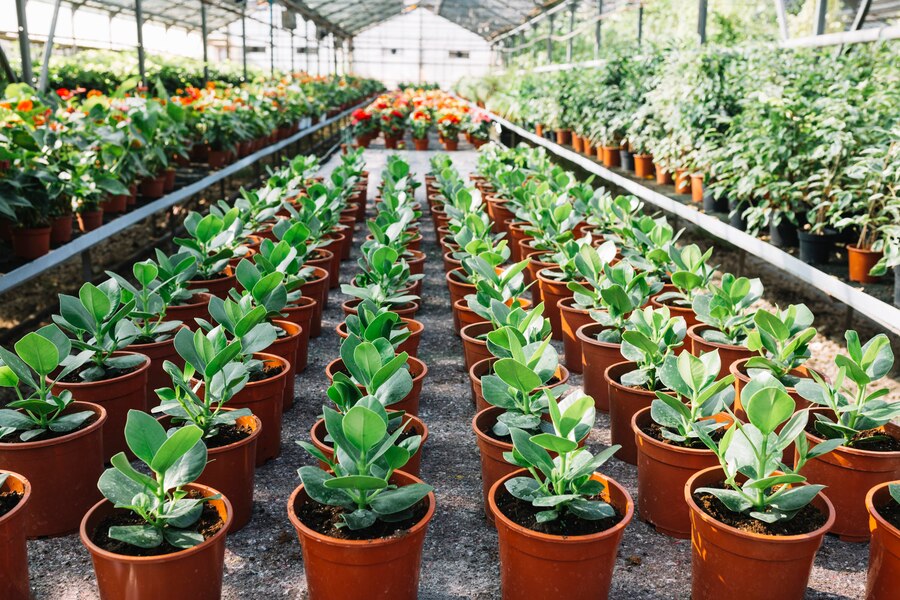
Another important aspect of maintenance is keeping the system clean. Regularly cleaning and sterilizing the reservoir, growing trays, and any other equipment will help prevent the buildup of algae, bacteria, and other contaminants that can harm plant health. It is also advisable to regularly inspect the plants for signs of pests or diseases, as prompt identification and treatment can prevent the spread of infestations. Finally, having a backup plan in place for power outages or equipment failures is essential to minimize the impact on the plants and maintain optimal growing conditions. With a proactive approach to maintenance and troubleshooting, gardeners can enjoy healthy and thriving hydroponic gardens year-round.
• Regularly monitor nutrient levels, pH levels, and water temperature
• Check pumps, filters, and air stones for proper circulation and oxygenation
• Keep the system clean by regularly cleaning and sterilizing equipment
• Inspect plants for signs of pests or diseases to prevent infestations
• Have a backup plan in place for power outages or equipment failures
Understanding the Importance of Water Quality in Hydroponics
Water quality is a crucial factor to consider when it comes to hydroponics. Unlike traditional soil-based gardening, water is the primary medium for delivering nutrients to the plants in a hydroponic system. As such, any impurities or imbalances in the water can directly impact the health and growth of the plants.
One key aspect of water quality in hydroponics is its pH level. pH measures the acidity or alkalinity of the water and greatly affects nutrient absorption by the plants. Generally, most hydroponic crops thrive in a pH range of 5.5 to 6.5. Deviations from this optimal range can result in nutrient deficiencies or toxicities, leading to stunted growth or other adverse effects. Monitoring and adjusting the pH of the water is essential to ensure the plants can effectively uptake the necessary nutrients for their growth.
• pH level is a key aspect of water quality in hydroponics
• Most hydroponic crops thrive in a pH range of 5.5 to 6.5
• Deviations from this optimal range can cause nutrient deficiencies or toxicities
• Monitoring and adjusting the pH of the water is crucial for plant growth and nutrient uptake
Exploring Sustainable Practices in Hydroponics
Hydroponics is becoming an increasingly popular method of gardening due to its sustainable practices and numerous environmental benefits. Unlike traditional soil-based gardening, hydroponic systems use water as the primary medium for delivering nutrients to plants, eliminating the need for soil altogether. This soilless system greatly reduces water consumption, as hydroponics requires only a fraction of the water used in traditional gardening methods. In addition, the controlled environment of hydroponics minimizes the use of pesticides and herbicides, making it a more eco-friendly option for growing a variety of plants.
Furthermore, hydroponic systems offer the advantage of year-round gardening, regardless of climate or geographical limitations. By allowing gardeners to have complete control over the light, temperature, and nutrient levels, hydroponics provides the perfect environment for plants to thrive throughout the year. This not only ensures a more consistent and abundant harvest, but it also reduces the need for long-distance transportation of produce, thereby decreasing carbon emissions associated with the food supply chain. Additionally, hydroponics enables gardeners to cultivate crops in urban areas, using minimal space and maximizing productivity without compromising sustainable practices.
By adopting hydroponics as a gardening method, individuals can contribute to sustainable practices and environmental conservation while reaping the benefits of year-round gardening in a controlled and efficient manner. With the ability to conserve water, reduce chemical usage, and create an optimal growing environment, hydroponics has positioned itself as a viable solution to the challenges of traditional gardening methods. Whether you are a gardening enthusiast or an urban dweller with limited outdoor space, exploring the sustainable practices of hydroponics can offer a rewarding and environmentally conscious approach to cultivating your own fresh produce.
• Hydroponics uses water as the primary medium for delivering nutrients, eliminating the need for soil and reducing water consumption.
• The controlled environment of hydroponics minimizes the use of pesticides and herbicides, making it a more eco-friendly option.
• Hydroponic systems allow year-round gardening regardless of climate or geographical limitations.
• Complete control over light, temperature, and nutrient levels in hydroponics ensures consistent and abundant harvests.
• Hydroponics reduces the need for long-distance transportation of produce, decreasing carbon emissions in the food supply chain.
• Cultivating crops using hydroponics maximizes productivity in urban areas with limited space while maintaining sustainable practices.
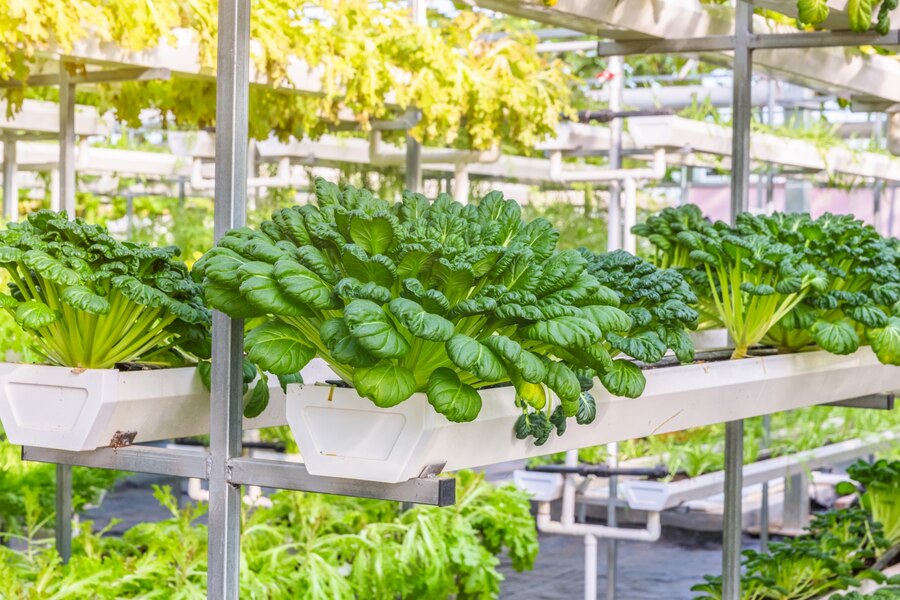
Tips for Successful Harvests in Hydroponic Gardening
A successful harvest in hydroponic gardening requires careful attention to key factors such as nutrient balance, plant health, and environmental conditions. To ensure optimal yields and healthy plants, consider the following tips:
1. Monitor nutrient levels: Nutrient solution plays a crucial role in hydroponic systems, as it directly provides essential elements for plant growth. Regularly test the pH and electrical conductivity (EC) levels to maintain a balanced nutrient solution. Adjust the pH as necessary, aiming for a range of 5.5 to 6.5 for most crops. By closely managing nutrient levels, you can prevent deficiencies or toxicities that could impair plant growth.
2. Maintain proper lighting: Light is paramount for photosynthesis and overall plant development. Understand the light requirements of your chosen plants and select lighting systems accordingly. LED grow lights have gained popularity in recent years for their energy efficiency and customizable spectrum. Ensure that the lighting duration and intensity align with the plants’ needs at different growth stages. Regularly inspect and clean the lights to maximize their output and longevity.
Remember, these tips are just the beginning of your journey toward successful harvests in hydroponic gardening. Stay tuned for more valuable insights on optimizing your indoor garden and achieving bountiful yields.
• Regularly test the pH and EC levels of the nutrient solution to maintain a balanced nutrient balance.
• Adjust the pH as necessary, aiming for a range of 5.5 to 6.5 for most crops.
• Prevent deficiencies or toxicities by closely managing nutrient levels.
• Understand the light requirements of your chosen plants and select lighting systems accordingly.
• LED grow lights are energy efficient and offer customizable spectrum options.
• Ensure that lighting duration and intensity align with plants’ needs at different growth stages.
• Regularly inspect and clean lights to maximize their output and longevity.
Choosing the Right Growing Medium for Your Hydroponic System
When it comes to hydroponic gardening, one crucial decision you’ll need to make is selecting the right growing medium for your plants. Unlike traditional soil-based gardening, hydroponics relies on a soilless medium to provide support and deliver water and nutrients to the plants. There are several different options to choose from, each with its own unique advantages and considerations.
One popular choice for hydroponic systems is rockwool. Made from melted basalt and spun into fibers, rockwool offers excellent water retention and aeration properties. It provides a stable and sturdy structure for the plant roots while allowing for ample oxygenation. Another commonly used medium is coco coir, which is derived from the fibrous husk of coconuts. Coco coir has excellent water retention capabilities and offers a balanced nutrient profile. It is also environmentally friendly and easy to dispose of after use. Other options include perlite, vermiculite, and clay pellets, each with their own set of benefits and considerations. Ultimately, the choice of growing medium will largely depend on factors such as plant type, system setup, and personal preferences.
• Rockwool: Made from melted basalt and spun into fibers, provides excellent water retention and aeration properties
• Coco coir: Derived from the fibrous husk of coconuts, has excellent water retention capabilities and offers a balanced nutrient profile
• Perlite: Lightweight volcanic glass that promotes drainage while retaining some moisture, suitable for plants that prefer drier conditions
• Vermiculite: Expanded mineral material that retains moisture well but may compact over time, often used in seed starting mixes
• Clay pellets: Lightweight and porous balls made from heated clay, provide good drainage and oxygenation for plant roots
Considerations when choosing a growing medium:
– Plant type: Different plants have varying needs in terms of water retention, aeration, and nutrient requirements. Research the specific requirements of your chosen plants to determine which medium is best suited.
– System setup: The type of hydroponic system you are using can also influence the choice of growing medium. For example, systems with recirculating nutrient solutions may require media with better drainage to prevent root rot.
– Sustainability: Consider environmentally friendly options such as coco coir or rockwool that can be easily disposed of after use without harming the environment.
– Personal preferences: Some growers may have personal preferences based on previous experience or ease of handling certain mediums.
Ultimately, selecting the right growing medium for your hydroponic system is essential to ensure optimal plant growth and productivity. Take into account factors such as water retention abilities, aeration properties, nutrient profiles, sustainability aspects, plant requirements,and personal preferences before making your decision.
Please do watch video!
What are the benefits of using hydroponic systems for indoor gardening?
Hydroponic systems allow for precise control of nutrient levels, water usage, and lighting, resulting in faster growth, higher yields, and the ability to grow plants year-round.
What are the different types of hydroponic systems?
There are several types of hydroponic systems, including nutrient film technique (NFT), deep water culture (DWC), aeroponics, drip irrigation, and ebb and flow.
What factors should I consider before choosing a hydroponic system?
Factors to consider include available space, budget, desired plant varieties, level of expertise, and the amount of time and effort you are willing to dedicate to maintaining the system.
How should I evaluate my space and budget for a hydroponic system?
Assess the available space in terms of size, ventilation, and lighting options. Consider your budget for purchasing the necessary equipment, supplies, and ongoing maintenance costs.
How can I assess my goals and level of expertise in hydroponics?
Determine what you hope to achieve with your hydroponic system, whether it’s simply growing fresh herbs or aiming for high-yield commercial production. Assess your level of experience and knowledge in hydroponics to choose a system that matches your skills.
What are nutrient delivery methods in hydroponic systems?
Nutrients can be delivered through the water in various ways, such as in a nutrient solution continuously flowing through the roots (NFT), misted onto the roots (aeroponics), or delivered through drip irrigation or ebb and flow systems.
What are the different lighting options for hydroponic setups?
Common lighting options include fluorescent lights, high-intensity discharge (HID) lights, and light-emitting diodes (LEDs), each with its own advantages and considerations in terms of cost, energy efficiency, and light spectrum.
Why is pH and EC levels important in hydroponics?
pH and EC (electrical conductivity) levels affect nutrient uptake and plant growth. Maintaining the appropriate pH level ensures nutrients are accessible to plants, while EC levels indicate the nutrient concentration in the water.
How do I choose the right growing medium for my hydroponic system?
The choice of growing medium depends on factors such as the type of hydroponic system, plant variety, and personal preference. Options include rockwool, perlite, vermiculite, coconut coir, and more.
What are the pros and cons of soilless hydroponic systems?
Soilless hydroponic systems offer advantages such as water efficiency, disease prevention, and faster growth. However, they require more precise monitoring and nutrient management compared to traditional soil-based gardening.
Which plant varieties are suitable for hydroponics?
Many plant varieties can be grown hydroponically, including leafy greens, herbs, tomatoes, cucumbers, peppers, and strawberries. Some larger fruiting plants may require larger systems or additional support.
Should I consider automation and control systems for my hydroponic setup?
Automation and control systems can help regulate environmental factors such as temperature, humidity, lighting schedules, and nutrient delivery, providing more consistent and efficient plant growth.
How can I maintain and troubleshoot my hydroponic system?
Regular maintenance includes monitoring pH and EC levels, checking for clogged or malfunctioning components, cleaning and sterilizing equipment, and ensuring proper nutrient balance. Troubleshooting may involve identifying and resolving issues such as nutrient deficiencies, pest infestations, or system leaks.
Why is water quality important in hydroponics?
Water quality affects plant health and nutrient uptake. It is important to use clean, filtered water free from contaminants and to monitor and adjust pH and nutrient levels accordingly.
What are some sustainable practices in hydroponics?
Sustainable practices in hydroponics include using renewable energy sources, recycling water and nutrients, implementing efficient irrigation systems, practicing integrated pest management, and reducing waste through proper disposal and recycling.
What are some tips for successful harvests in hydroponic gardening?
Tips for successful harvests include maintaining proper lighting, temperature, humidity, and nutrient levels; pruning and training plants for optimal growth; monitoring and adjusting pH and EC levels regularly; and practicing good sanitation and pest prevention measures.

Nicole Burke is a dynamic writer at SouthElMonteHydroponics, fueled by her passion for horticulture and environmental sustainability. Armed with a degree in Environmental Science from a renowned institution, Nicole’s expertise lies in hydroponic gardening, organic farming, and biodiversity conservation. Her insatiable curiosity and love for nature drive her to explore innovative techniques in hydroponics, seeking to revolutionize the way we grow crops in urban environments. Nicole’s writing reflects her deep commitment to promoting eco-conscious practices and fostering a deeper connection between humans and the natural world. Through her engaging storytelling, she inspires others to embrace sustainable living and harness the power of hydroponics for a greener future.

